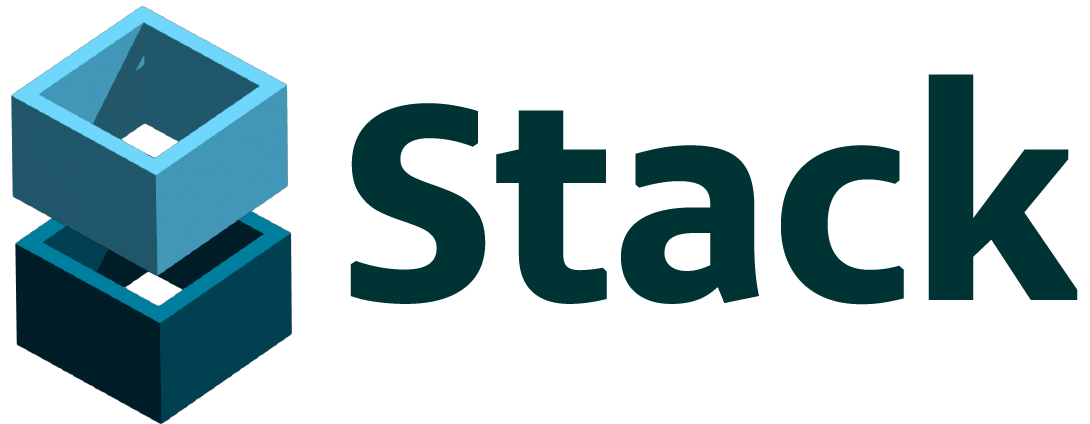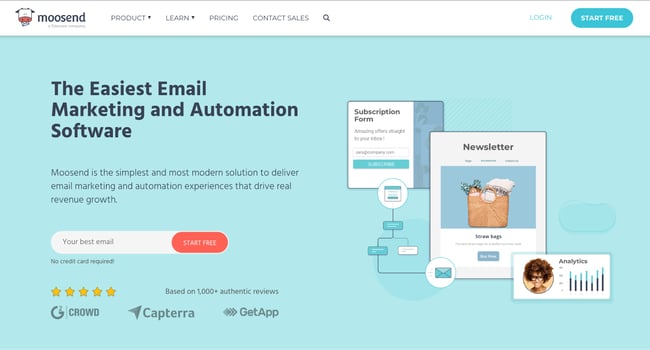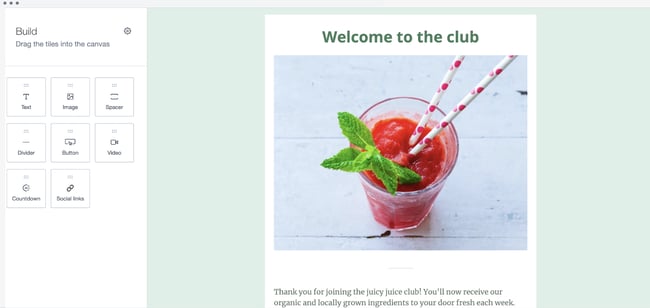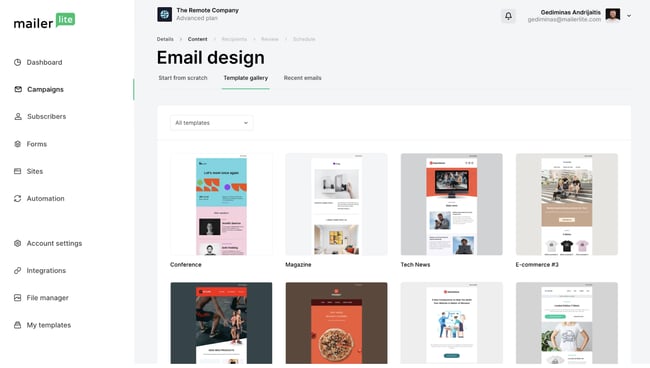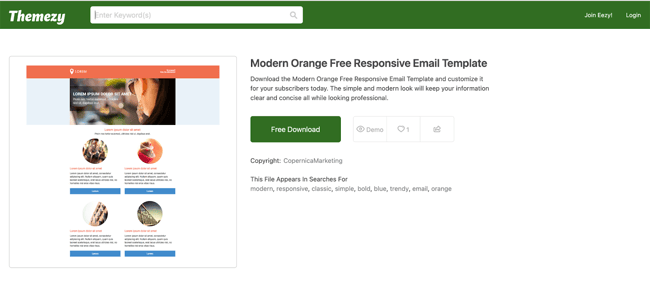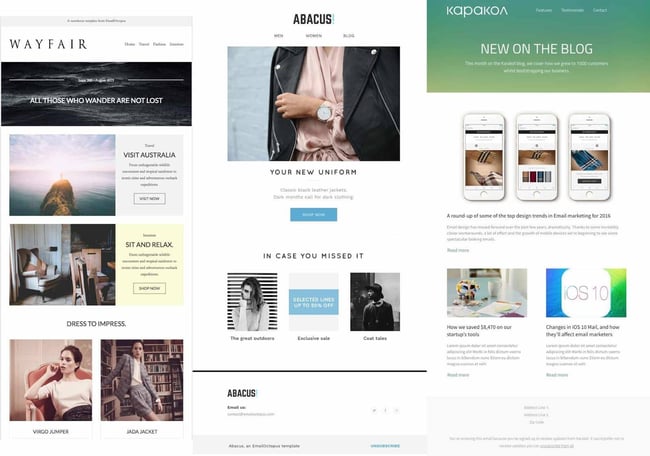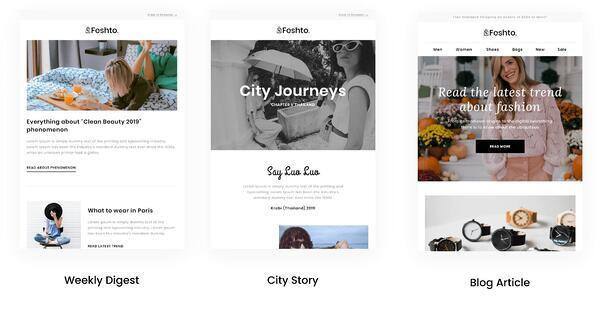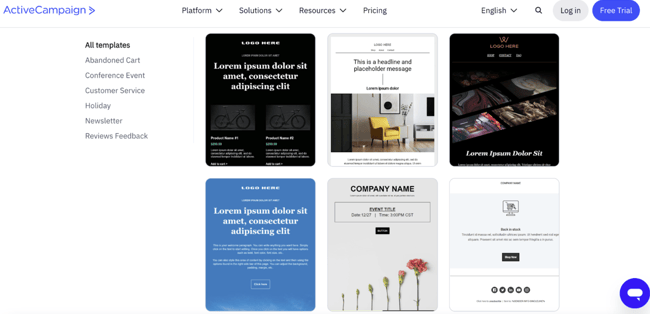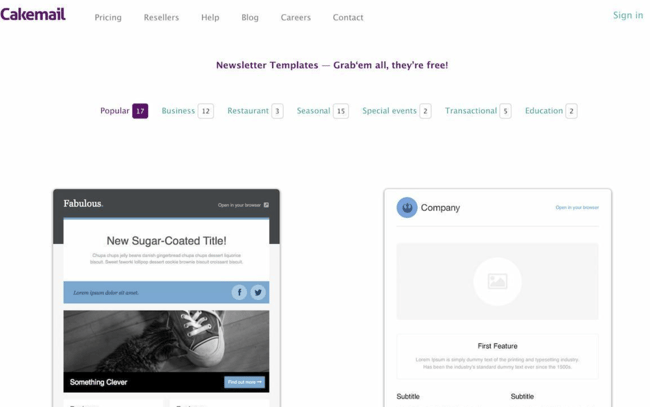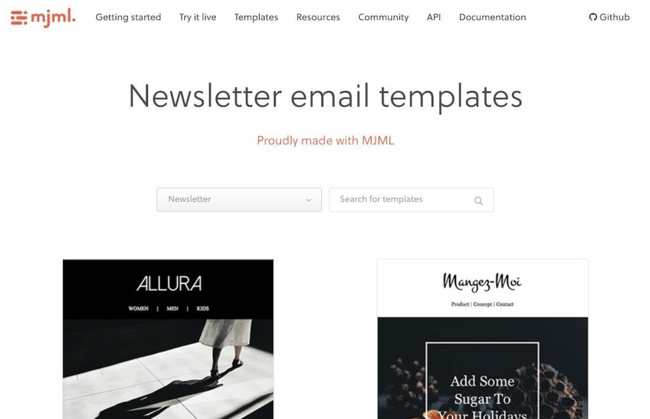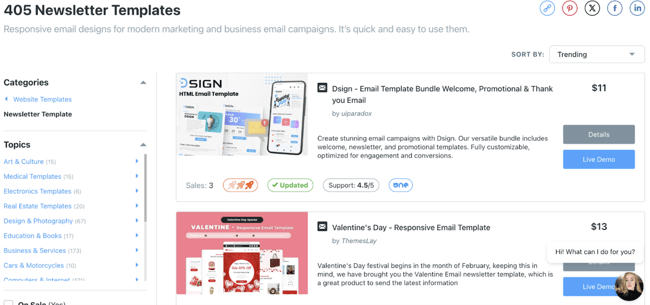Our view at Stack - Simplify growth with an all-in-one platform. Powerful marketing, sales, and support automation. Integrated CMS. Scalable software. Crafted for customer experience.
There’s no end to the number of newsletters you can subscribe to. Email marketers have a lot to compete with in their subscribers’ inboxes.
If you’re wondering how email marketers get through, check out free email newsletter templates that make it easier to design a newsletter.

That’s why a solid newsletter template is crucial to designing an email that people are encouraged to click through. Discover some of my favorites below, plus tips for encouraging engagement.
Table of Contents
- What is email newsletter design?
- Why Use Email Newsletter Templates for Your Next Campaign?
- Free Email Newsletter Templates
- Best Places to Find Newsletter Templates
- How to Customize Email Newsletter Templates to Increase Engagement
What is email newsletter design?
Email newsletter design encompasses every aspect of the structure and aesthetic of your email newsletters, such as font, images, colors, logos, content, and template layout.
From your subject line to your layout, your newsletter must be cohesive and optimized to entice readers to click and stay subscribed.
Why Use Email Newsletter Templates for Your Next Campaign?
Creating a template from scratch can be time-consuming and a bit daunting, especially if you’re not very design-savvy. Email newsletter templates give email marketers a solid foundational design they can tweak to their liking.
By using an email design template in your next campaign, you can quickly and effectively create a consistent newsletter style that can be easily maintained even in the event it gets passed onto another DRI.
“I became the DRI for HubSpot’s Marketing Daily Newsletter a few years into its inception,” HubSpot marketing manager and writer Erica Santiago says. “Fortunately, there was already a solid, tried-and-true template that made transitioning into the responsibility easy, so our audience never noticed a change in who was curating it.”
If done well, email newsletters can do wonders to help you build an engaged subscriber base, keep your business top-of-mind, and nurture leads that are already making their way down the funnel.
However, “done well” means more than just serving up great content. In fact, an often overlooked component of the newsletter creation process is the design.
Don’t have time to build out a custom template from scratch?
I’ve scoured the internet for the best resources for email newsletter templates and compiled them below.
Many of the templates have also been pre-tested for compatibility with major email service providers (ESPs) via Litmus — a web service that allows you to preview the way your email will look on different email clients and devices.
Once you find one you like, download the template and customize it to fit your needs. Depending on compatibility, you can even try out newsletter layouts on Google, Outlook, and other email providers.
1. HubSpot
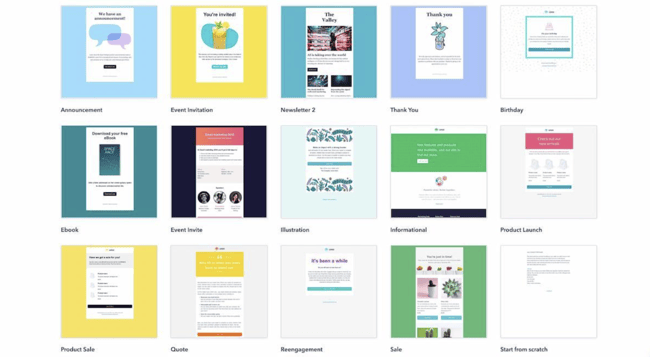
Start using HubSpot’s free Email Template Builder
Price: Free and paid options available
If you’re a Marketing Hub user, HubSpot offers a great collection of email templates you can use on your next marketing email.
No need to log out and search for a template in another marketplace; these templates are available to you right within the tool.
Once you choose a template, you can start using it immediately right in HubSpot — no HTML or CSS required. I specifically use HubSpot for the templates because of how easy they are to use and the variety of options available.
What I like: HubSpot provides a complete, end-to-end solution for all your marketing requirements since it provides access to our comprehensive CRM, centralizing your customer data.
As an email marketing platform, you can look through hundreds of templates tailored to your subject, content type, customer profile, and customer stage in your funnel. These templates can be customized using your unique customer information in the CRM.
The email solution offers excellent analytics and A/B testing capabilities, so you can keep improving your marketing plan over time.
Best For: Email marketers who have or wish to have multiple newsletters dedicated to different topics associated with your organization.
2. Litmus
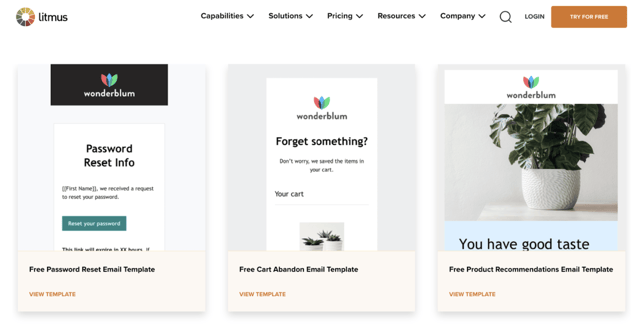
Price: Free
Litmus offers a free email template collection — from newsletter templates to account management templates. All of the templates have been tested with the platform.
While you are required to create a Litmus account with your email address to access the templates, the templates themselves are free of charge.
What I like: Along with the multiple template options, Litmus provides strong customization options like countdown timers to highlight the urgency of a sale or event, progress bars to encourage brand loyalty, and real-time sentiment monitors, which can increase email engagement and revenue.
With its easy-to-use email builder, you can effortlessly access AI-powered email content optimization capabilities such as suggested subject lines and alternate body text tones. Something that I think is quite time-saving in this day and age!
Best For: A retail brand or business that sells food, clothes, or other products. You’ll especially enjoy the countdown timers I mentioned earlier.
3. ConvertKit
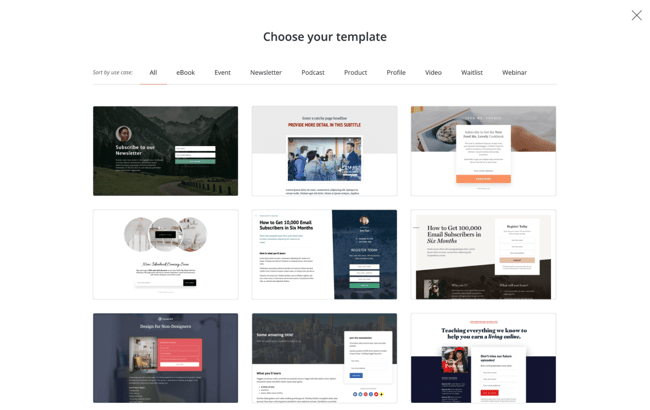
Price: Free and paid options
ConvertKit is a creative email template platform that’s a great option for bloggers, course creators, and more. ConvertKit comes with email automation tools, sign-up forms, and many more integrations.
To use ConvertKit’s email newsletter templates, you’ll need to sign up for a plan, but the good news is that they offer both free and pro subscriptions.
While this platform is more on the creative side, its vast array of templates and tool integrations will help businesses in any industry upgrade their email newsletter.
What I like: Since ConvertKit is mostly aimed at digital content creators, it helps you grow your subscriber lists, send targeted newsletters, increase product sales, and establish membership sites. You can also easily embed email marketing and subscriber forms anywhere on your WordPress website.
What I find unique about ConvertKit is its ability to use the A/B test function to compare two distinct subject lines.
It will split-test the subject lines (15% for each line) for the first 30% of your emails. The other 70% of the emails will have the subject line that receives the most opens.
Best For: Content creators and influencers looking to grow their email lists.
4. ZURB: Foundation for Emails
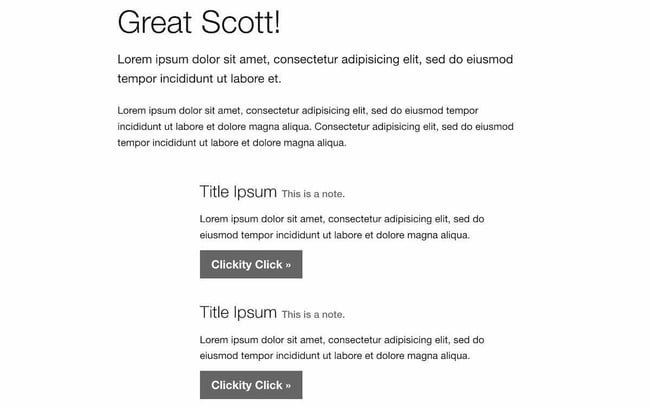
Price: Free
ZURB Studios has 11 responsive email templates available for free, including the newsletter one below. It has a great, fluid layout you can customize with your own colors, images, and wording.
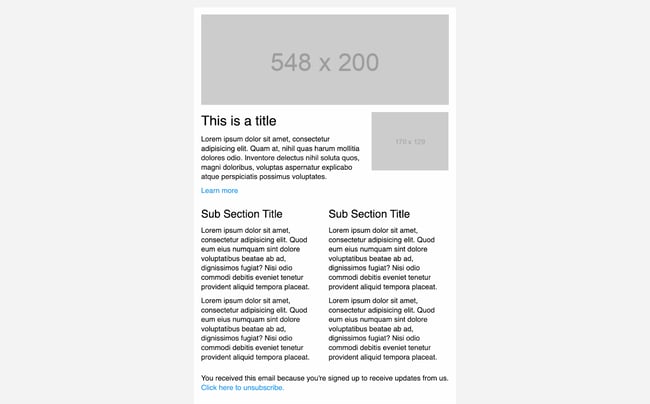
If you want to see how each template looks on different email clients, you can check out screenshots from each template’s email client tests, which are available on the site. These layouts are optimized for most email clients — except for outdated versions of Outlook.
The template kit comes with a separate CSS stylesheet and HTML file to ease the editing process. Most email code editors will place the CSS in line with the HTML itself after both are uploaded separately.
If you’re going to add images to your newsletter, keep in mind that you’ll have to create a separate folder and compress it with the CSS stylesheet before uploading.
What I like: I personally find Zurb’s Masterclass best — because it’s perfect for beginners to learn how to use the templates. You even get three free tutorials on responsive email design.
Pro tip: Once you’ve selected a template, use HubSpot’s free email marketing software to craft your message and send a newsletter out to the world!
Best Used For: Beginners learning to design emails for the first time.
5. Postcards
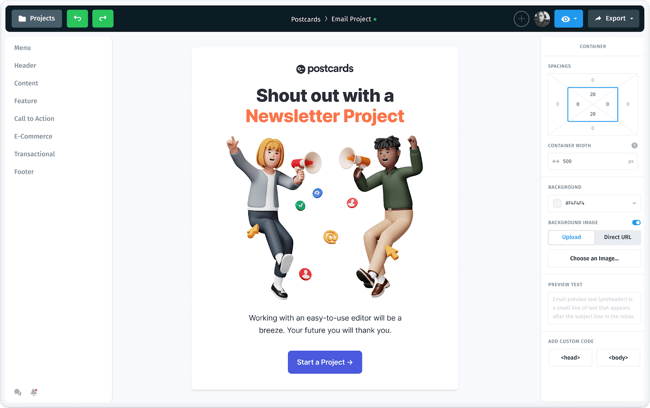
Price: Free, Plus — $16 per month, and Pro — $24 per month
Postcards provides some of the best-designed email template builders on the market that are up-to-date and require no previous coding experience.
With Postcards, you can easily create professional-looking emails with their pre-designed email templates that are customizable.
Their email builder is a game-changer for marketers, designers, and developers who want to streamline their email creation process and focus on what matters: crafting engaging content and design.
What I like: You know why I think Postcards works so well? It’s a no-code platform with exceptional content history and enterprise-level collaboration features. You can store your work in the detailed version history, allowing you to go back in time and recover a successful email template.
Best For: Marketers with little to no coding experience.
6. Flodesk
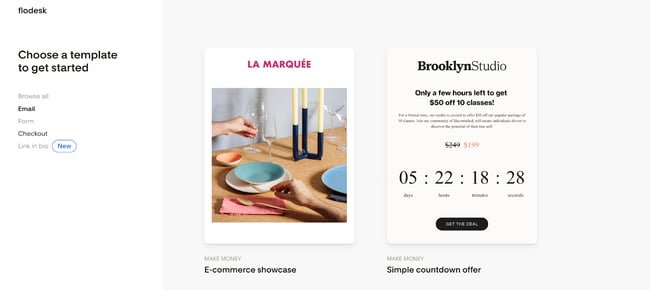
Price: Free for 30 days
Flodesk is an email newsletter design platform with over 3,000 email templates and designs to enhance your email marketing. Moreover, I’m a big fan of their contemporary template designs, which are quite eye-catching.
Aside from giving you access to a vast array of templates, Flodesk lets you connect your e-commerce site to help with automation and analytics.
Another benefit of Flodesk is that its subscription price ($38/month) is a flat fee. So, whether you’re sending 200 or 2,000 emails, you’ll pay the same price, and you’ll never have to upgrade your subscription to get all of the perks.
Pro tip: Want to segment your customers when sending them newsletters? Well, Flodesk allows you to sort your audience so that you stay as relevant as possible.
Best For: Marketers who leverage segmentation in their emails and who wish to effectively push readers to their e-commerce sites.
7. 99designs

Price: Free
99designs is a growing online community and collaboration platform for designers and small businesses, and they have a great designer blog and business blog.
As a free offering to their blog readers, they released a set of 45 free email templates — perfect for newsletters, promotional messages, and personalized responses. All of the templates are fully responsive and compatible with all major email clients.

Pro tip: What I think is great about 99designs is that you can also start a design contest to test custom email template options from various designers.
Best For: Marketers new to email marketing who will appreciate 99designs helpful community and intuitive templates.
8. Moosend
Price: Free for 30 days, Pro — $9 per month, Enterprise — custom
Moosend is an email marketing platform that makes it easy to design custom emails with a drag-and-drop editor and over 70 premade templates.
Moosend also tracks analytics and sends personalized automated emails to subscribers based on their interests and behavior. If you’re interested in landing pages and subscription templates, it includes those as well.
Moosend analyzes your subscriber base to help your business succeed. Like Flodesk, it lets you connect your e-commerce site to attract more subscribers and store all information in one place.
Moosend is free for the first 30 days, and then you would have to upgrade to pro status for $9/month. However, if you choose the annual pro plan, it comes up to $7/month.
Pro tip: There’s no need to export templates — you can actually send your email newsletters through the platform. This makes it that much more convenient, in my opinion.
Best For: Marketers who wish to connect their emails to their e-commerce sites and looking for a convenient all-in-one email marketing platform.
9. Bee Free
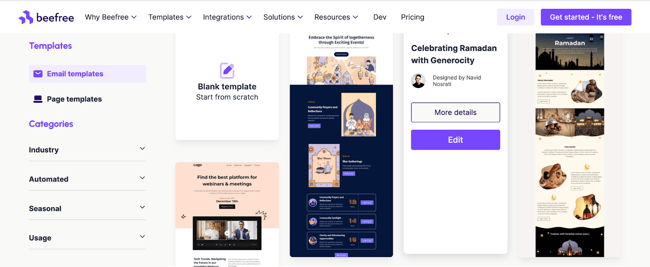
Price: Free and paid options available
BEE Free is the ultimate solution for creating captivating emails without any coding skills. With its extensive library of over 1,500 responsive templates, you’ll have a wide range of options to bring your email designs to life.
Plus, I love that there’s no sign up needed. You can just start as is.
They provide a drag-and-drop functionality that empowers you to create on-brand newsletter emails easily, ensuring your message resonates with your audience.
Its collaborative features enable multiple team members to work together seamlessly on email templates, streamlining your workflow and boosting productivity.
BEE Free’s seamless integration with Hubspot allows you to effortlessly export your email designs for a smooth transition.
With its extensive template library, user-friendly interface, and seamless HubSpot integration, you can create stunning, responsive email designs in no time.
Pro tip: There’s even an option to hire a designer on the platform who can help you customize your email templates.
Best For:
10. Campaign Monitor
Price: Free for 30 days, plans start at $11per month
Campaign Monitor is another free email newsletter template and marketing platform. With a variety of email templates for newsletters, welcome emails, and promotional campaigns, Campaign Monitor makes designing emails easy.
Campaign Monitor also compiles your analytics and tracks when emails are sent, delivered, and opened.
For many businesses, email marketing needs to connect to their website or ecommerce site, and Campaign Monitor does just that.
Campaign Monitor has it all when it comes to templates and helps you maximize your sales by staying on-brand and creating a seamless customer experience.
What I like: Campaign Monitor has one of the most unique features I’ve encountered in an email builder. That is — you can lock specific areas of the template so that your team alters only the information you want them to. This protects your brand identity and important business data.
11. MailerLite
Price: Free and paid plans are available
MailerLite offers various newsletter templates for promotions, announcements, and more. With its trendy newsletter designs, MailerLite makes sure its customers stay up to date while sending newsletters.
You can customize the templates using either an HTML editor or a drag-and-drop editor. You’re also able to connect your MailerLite account to your website. MailerLite has features that allow you to grow your audience with landing pages, subscription forms, and pop-ups.
MailerLite provides data insights as well. One thing I find useful about MailerLite is that they will send your emails based on your customers’ time zones, allowing you to send emails that get the most opens. MailerLite also provides A/B split testing tools so you can identify the best version of every email you send.
Pro tip: With the free plan, you can create your own custom templates. However, if you want to access their template options, you’ll have to look into their paid plans.
Best for: Organizations with customers in various time zones.
12. Sender
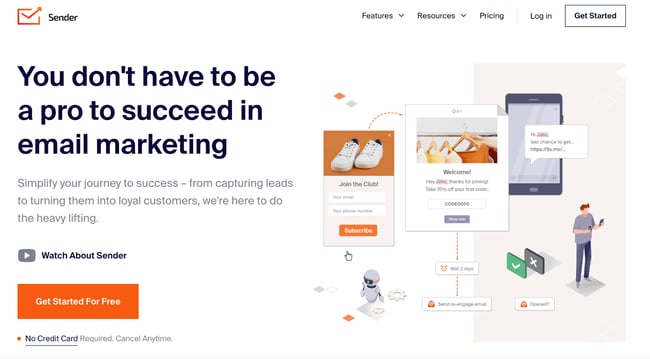
Price: Free and paid options available
Sender is an all-in-one email and SMS marketing platform for ecommerce and small to medium-sized businesses who want to reach out to their customers at an affordable and accessible price.
Sender provides delivery-friendly text and branded HTML email newsletters to connect with your email subscribers and biggest fans.
Choose from a library of 35+ visually stunning, premium-feel newsletter design templates that are fully customizable to your specific business requirements.
In addition, all templates have responsiveness baked into the design so that your emails are guaranteed to play nicely on mobile devices.
Besides offering advanced email marketing features such as segmentation and automation, Sender also allows you to design highly responsive and eye-catching pop-ups and forms to attract sign-ups and execute SMS marketing for higher conversions.
Sender has a ton of affordable price points and capabilities even in their free account.
With the Free Forever plan, you can send up to 15,000 emails every month to 2,500 contacts at no cost, with premium features such as segmentation and automation bundled together.
What I like: The best part of using Sender is the access to their support team. And not to mention, I was surprised by their swift response time!
Best For: Email marketers on a budget.
13. Constant Contact

Price: $12 per month or $80 per month
Do you run a non-profit? If so, this is the newsletter tool specifically for you. Constant Contact is an email newsletter builder that offers specific templates to help nonprofits raise funds and market their missions.
With hundreds of templates to choose from, you’ll be sure to find a design based on the template you need and what type of nonprofit you run.
The great thing about Constant Contact is the business analytics. While using the platform, you can see when emails are sent, delivered, opened, and shared. You will also be able to see top trends and send personalized emails to your clients.
Constant Contact also connects with your social media profiles, includes sign-up forms, and offers text message marketing tools.
Contacting your non-profit subscribers via text message can be a great advantage because people check their emails, but people check their text messages more.
While Constant Contact is not free, its features more than make up for it. You can start with the basic subscription ($12/month) or upgrade to a premium account ($80/month) to unlock all the features.
What I like: Fundraising is easier with their integration options, such as DonorPerfect, Blackbaud, Neon CRM, and Qgiv. I found it easy to add any features to promote the event properly.
Best For: Non-profit organizations.
14. Themezy
Price: Free
Download 16 free HTML, CSS, and PSD customizable email templates on Themezy. You don’t have to submit an email address to get started, and there are various color schemes and layouts to meet your email list’s needs.
Pro tip: The templates are designed to be responsive across devices to ensure that your subscribers can read your newsletter. So, if you’re sending emails on every gadget like I am, you can be sure that your template works regardless.
Best for: Sending marketing emails on multiple devices.
15. Drip
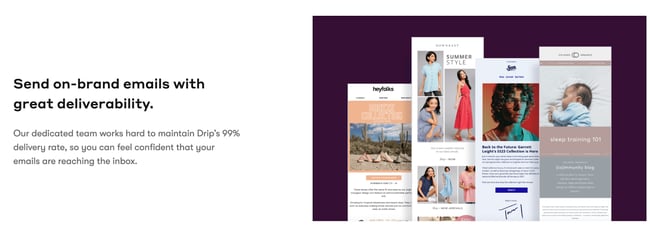
Price: Free for 14 days, then payments based on the number of subscribers
Drip offers email marketing and SMS marketing for e-commerce brands. Drip is a new platform that lets you set up email marketing campaigns through hundreds of customizable templates.
Along with their email newsletter templates, Drip offers excellent customer relations management tools, data analytics, and trend trackers. Through that, you can see how many of your customers bought red shoes within the last year.
As a result, you’ll be able to better market yourself through your campaigns. Drip also has integrations that you can connect to your WordPress website, so you can use Drip without being on Drip.
Drip lets you start with a free 14-day trial, and the cost of your subscription will depend on your number of contacts. For up to 500 contacts, it’s $19/month, and the price goes up from there.
Drip is beneficial to creators and ecommerce businesses because of the various marketing and analytics tools it offers. From email marketing to SMS marketing campaigns, Drip lets you effectively engage your customers.
What I like: You know what I find convenient about Drip? It comes with 150 native integrations, so you can use it with almost any marketing platform.
Best For: E-commerce brands.
16. MailPortfolio by SliceJack
Price: Free
If your marketing strategy is heavily reliant on visuals, MailPortfolio is perfect for you. It’s a minimalist template with no added background distractions.
While it was made for those looking to display personal creative portfolios, it’s also suitable for larger businesses and organizations.
The template has been tested with Litmus, is responsive, and works perfectly on all email clients. (Note: older versions of Outlook may not render all of the fonts, and the Android Gmail app is not fully supported.)
Pro tip: Make sure you don’t use the stock images on the MailPortfolio template. You have to change them — otherwise, your newsletters won’t work as well. Something I learned the hard way.
Best For: Email marketers who love visuals.
17. Material Design by Paul Goddard
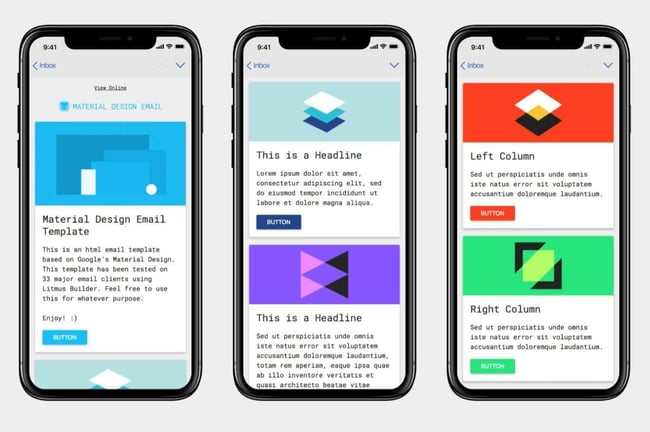
Price: Free
This template is based on Google’s Material Design and has a robotic-retro feel. It is perfect for sending out multi-purpose newsletters featuring new products, events, and other announcements at the same time.
This theme isn’t made for a specific industry, but the template is well-fitting for businesses looking for a timeless, technological look.
Material Design has been tested on Litmus, is compatible with all major ESPs, and is responsive. While its main attraction is its unique design, this theme download also includes customizable HTML files.
Pro tip: What I’ve learned is that if you’re having trouble downloading the template, you can access it from Paul’s Google Drive link, too.
Best For: Multi-purpose newsletters.
18. Briar by SliceJack
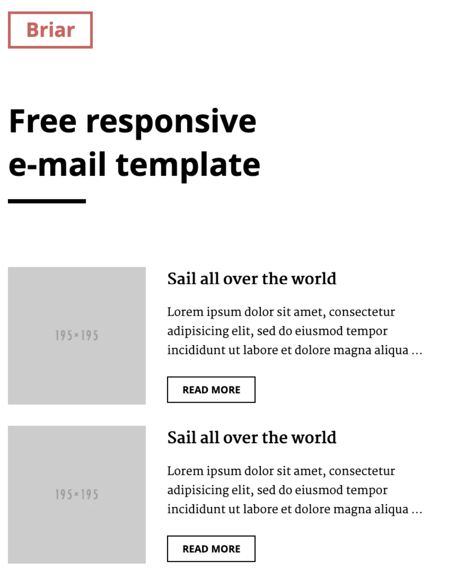
Price: Free
Briar is the perfect newsletter template for marketers looking for a fluid, minimalist design featuring images and text that don’t overshadow each other.
It’s perfect for sending out regular newsletters, and you can customize the inline CSS files.
The template has been tested with Litmus and works with all major ESPs. However, some older versions of Outlook may not render all Google fonts. Also, the Android Gmail app is not fully supported.
Pro tip: One hack I learned is that you can easily use these templates for your MailChimp campaigns with their own HTML file.
Best for: Marketers looking for a minimalist design.
19. EmailOctopus
Price: Free
EmailOctopus is a marketing service that launched a series of 11 templates that can be used to create newsletters for a variety of industries.
Whether you’re marketing for a fashion brand or a medical supply company, one of the templates will fit your needs.
The templates have the “typical” newsletter look but allow you to add product announcements, feature stories, and CTAs wherever you’d like.
All of the templates can be modified through any WYSIWYG editor, and the downloads include the HTML files.
These templates have been tested through Litmus across all major ESPs and are responsive to all screen sizes.
What I like: EmailOctopus is also GDPR compliant, so I find using all their free templates safe.
Best For: Product or sale announcements.
20. MailBluster
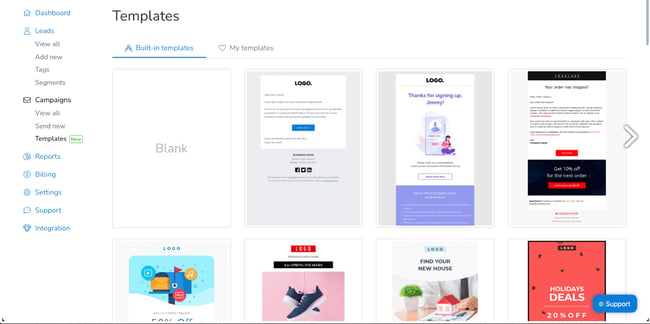
Price: Free and paid options available
MailBluster brings you an interactive solution for the best email newsletter design. Apart from all the essential email marketing features, MailBluster includes a hefty lot of free email newsletter templates.
Choose from a mass collection of their newsletter templates or create from scratch to build your own. Also, you can customize your own template by editing the existing one from their large template gallery.
These templates are compatible with all major ESPs. Combined with their powerful drag-and-drop editor and email automation feature, you can automate your email newsletter effectively.
Additionally, MailBluster also features interactive real-time tracking and reporting, list segmentation, A/B testing for email marketers, and more.
So, design eye-catching email templates and boost your sales via MailBluster!
What I like: MailBluster offers a free option that allows you to send 62k monthly emails and unlimited subscribers. This is probably the best deal for any company wanting bulk email services.
Plus, what I love most is that they provide one-to-one support regardless of the price tier you’re in.
Best For: Companies want bulk emails on a budget.
21. Klaviyo
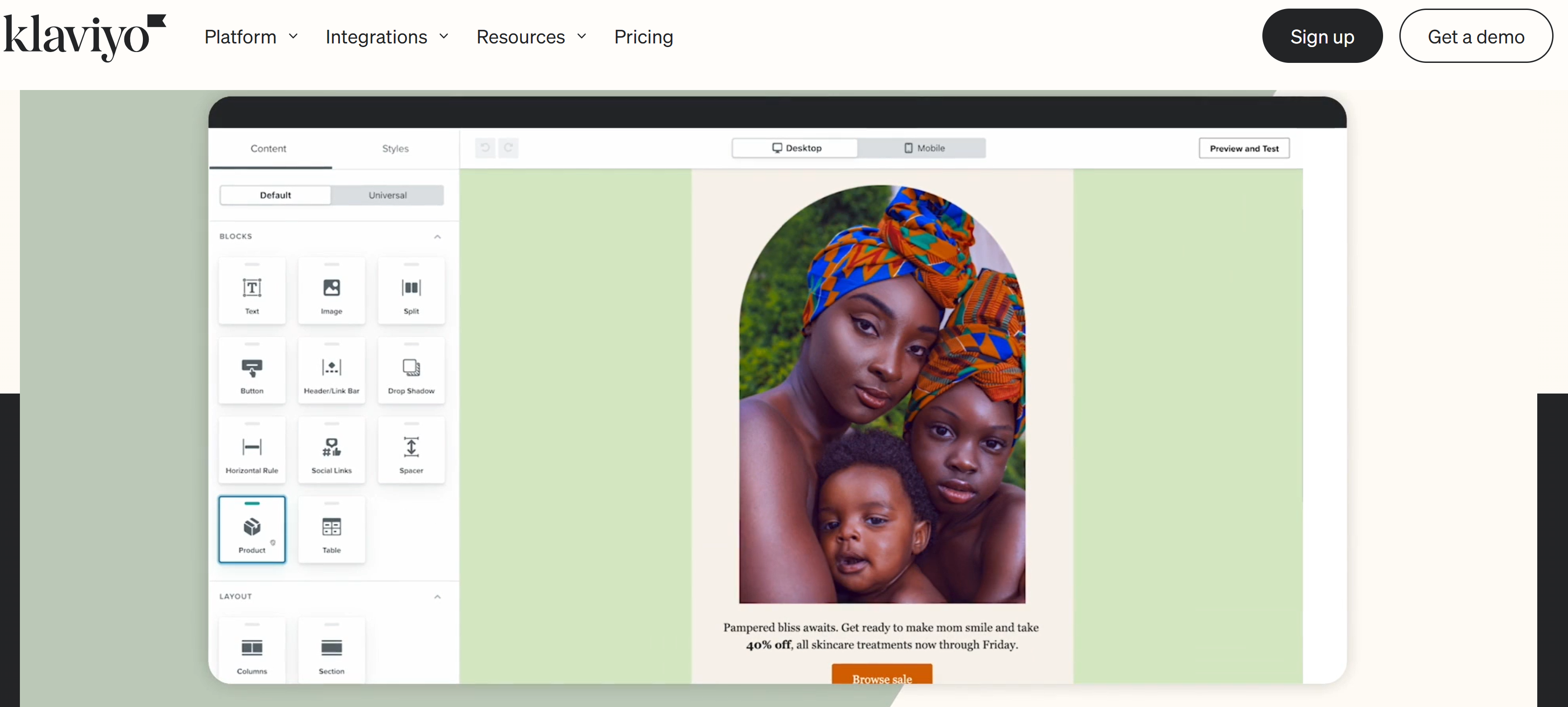
Unfortunately, I could not test Klaviyo myself because I didn’t get the demo in time for publishing; however, there are features that stand out to me that I believe make Klaviyo an email newsletter template platform worth checking out.
Of course, Klaviyo has what we’re all here for—aesthetically pleasing template designs. But there are other notable features.
Klaviyo pulls helpful data from your tech stack via custom and pre-built integrations from e-commerce platforms such as Shopify and Adobe Commerce. Klaviyo is also compatible with shipping platforms like ShipStation and AfterShip.
You can integrate platforms like Facebook Ads and Google Ads.
Klaviyo users can take this data from their integrations and use it to further personalize their emails. Then, Klaviyo can help you create a complete profile of every customer, which will consist of:
- The products/services they’ve ordered from you
- Their browsing history
- Product preferences
- Preferred channels
You can also automate your newsletter process via Klaviyo AI.
What I Like: Klaviyo’s features make segmentation and personalization simple.
Best For: E-commerce
22. Publicate
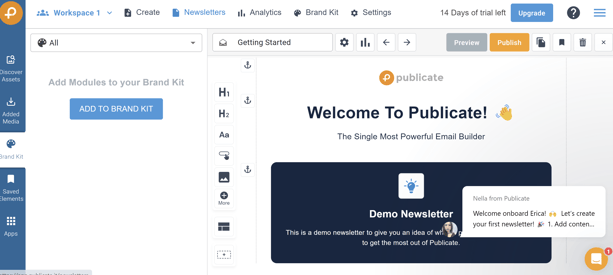
Publicate boasts a wide variety of email templates that you can customize for your brand.
Publicate also integrates with Gmail and Outlook and allows users to view detailed analytics of their emails’ performances.
What I Like: I especially enjoy that it includes a Brand Kit, in which you can upload brand images and logos to be used in your messages.
Best For: A wide variety of businesses and organizations.
23. Omnisend
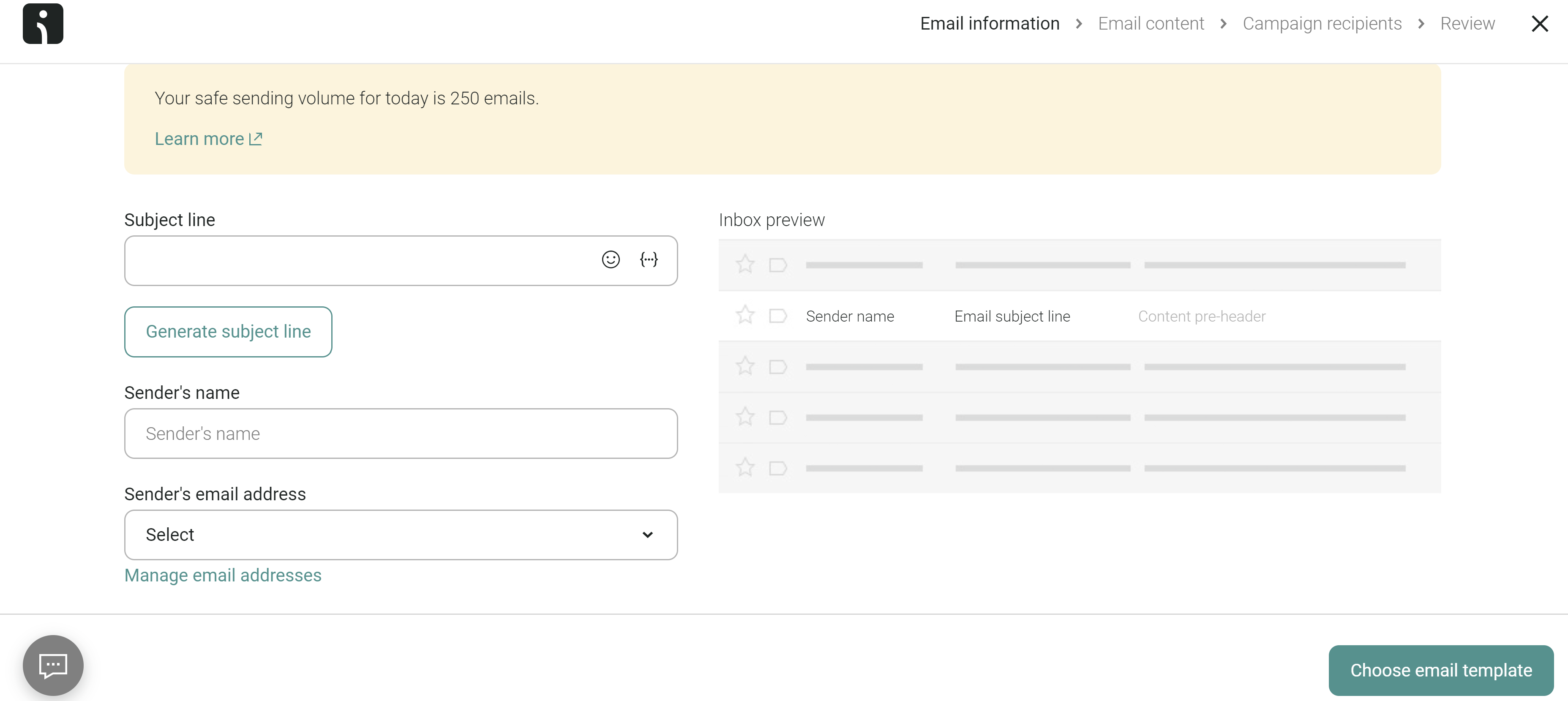
Omnisend is a marketing automation platform that operates email, push notifications, pop-ups, and more.
With Omnisend, users can set up campaigns across various channels and track metrics. You can also sync Omnisend to your store for better results.
What I Like: Omnisend leverages AI to help users come up with subject lines.
Best For: Marketers seeking an all-in-one email marketing platform
1. Feshto by Liramail
Price: $59 for an all-in-one bundle
Feshto is an email bundle that helps ecommerce companies feature products in their newsletters and share testimonials from satisfied customers. It comes with a weekly digest module, which is their version of a newsletter.
The module features a chic, clean design that ensures your images and copy are not distracting from each other. You can choose from their various layouts, such as “Weekly Digest,” “City Story,” and “Blog Article.”
As mentioned, these templates are perfect for product features and testimonials from satisfied customers. While the default themes are black and white, you can make edits in your preferred WYSIWYG editor.
Feshto’s templates are responsive and compatible with all major ESPs.
2. ThemeForest
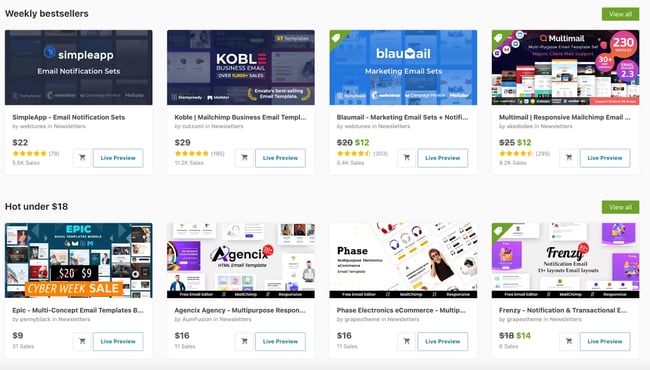
Price: $6-$29 per template
ThemeForest is an awesome resource for email templates if you have some budget to spend. Their library has over 460 newsletter templates in all different colors, styles, and themes.
The templates are rated using a four-star system, and you can filter by rating, price, recency, and popularity.
Here’s one example from its library:
Market – Responsive Newsletter with Template Builder ($20)
This template has eight prebuilt layouts, 24 color variations, 24 full-layered PSD files, and more. Plus, it’s supported by all major email clients.
3. HubSpot Email Copy Templates
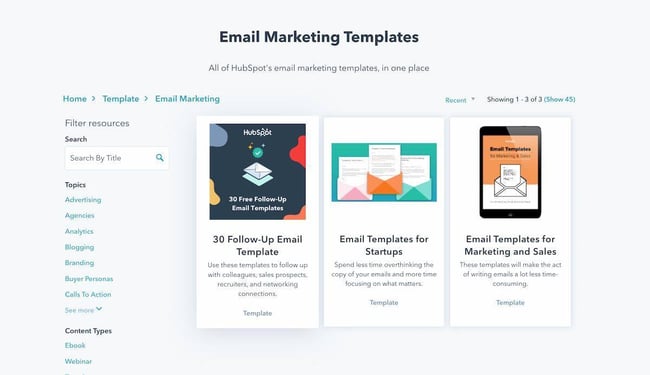
Price: Free
If you’re looking for written templates that you can put into your email tool, these are the templates for you.
HubSpot offers free email templates that empower you to market and sell your business over email without writing a single line from scratch. These free email template downloads save you time and money.
The templates can be downloaded right to your computer and can be used by any type of business.
4. Mailchimp
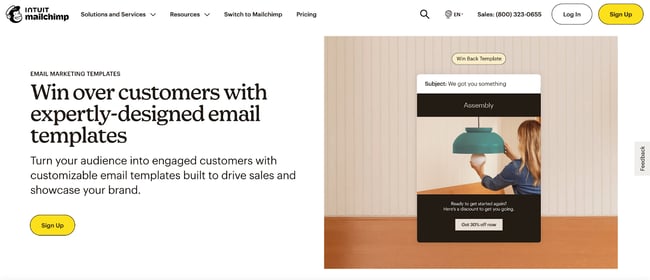
Price: Free to $350 per month
Mailchimp is an all-in-one marketing platform that helps small and large businesses scale and grow their business through marketing techniques and automations.
Mailchimp has a variety of pre-made templates in its email newsletter tool.
Aside from giving you over 100 designs to choose from, Mailchimp also gives you the option to download their Email Blueprints, which allows you to customize HTML templates.
5. ActiveCampaign
Price: Free to $259 a month
ActiveCampaign is a full-service email provider that offers email marketing automation and CRM tools.
Its library of newsletter templates allows you to create conversion-optimized, visually impactful emails without touching a single line of code.
ActiveCampaign is free, but you will need to sign up for an account to use and view their email templates. You can use the majority of their templates for free, but if you want some customization, you’ll want to upgrade to a paid account.
6. Canva
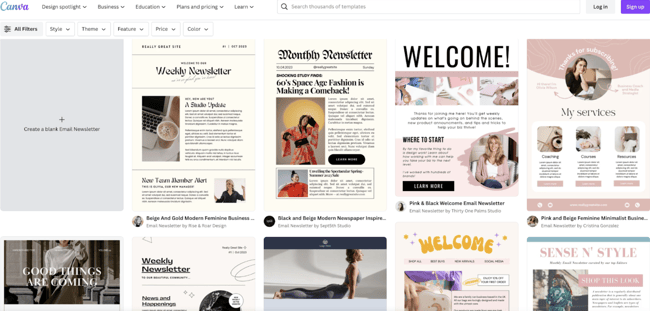
Price: Free — custom pricing per month
Canva is an online graphics software that provides free templates for a multitude of things like Instagram posts, resumes, and email newsletters.
Canva is a great tool because you can find free templates for specific niches like fashion, tech, culinary, and many more.
While there is a paid tier, many of the premade templates are free, and you can add your own customizations without having to pay extra.
7. Adobe Express

Price: Premium — $9.99 per month, teams — $12.99 per month
Adobe Express, formerly known as Adobe Spark, is another browser-based graphic design tool that has a multitude of templates and functions to help any company create a newsletter.
Similar to Canva, Adobe offers premade templates based on industry categories like photography, architecture, and fashion. To access the templates, you must sign up for an account with Adobe.
8. CakeMail
Price: Free
CakeMail is an email marketing tool that includes user-friendly automation tools and allows you to create customizable emails for any person, occasion, and niche.
CakeMail offers over 50 free editable email templates that are divided into smaller niche categories.
One of the advantages of CakeMail is that you do not have to sign up to use the email templates provided, but if you would like to see how your email campaigns are performing, you can register for an account.
9. MJML
Price: Free
MJML is an HTML-based email designer. They have a wide variety of free templates that are customized for the type of email marketing your company is trying to do, including newsletters, promotions, and seasonal emails.
Once you find a template that you like, MJML allows you to see the template and the HTML code in real time as you edit it.
Because MJML is HTML-based, you will have to copy your code and transfer it to the HTML editor in an email marketing service to use the template.
10. TemplateMonster
Price: Varies, pay per template
TemplateMonster offers a variety of email newsletter templates, all of which are available for relatively low prices.
Their templates are clean, customizable, and easy to use, and they’re compatible with most major email clients, such as Gmail and Yahoo Mail.
Additionally, the templates come with built-in responsive layouts for screen adaptability and PSD sources for a litany of customization options.
11. Microsoft Office Templates
Price: Free and paid email templates
Microsoft Office has a variety of tools, including extensive templates that can be used for Microsoft Word, Excel, and PowerPoint.
You can further narrow down your templates depending on the category of your business. While Microsoft does offer free templates, they are limited. For paid templates, you have to download Microsoft 365.
How to Customize Email Newsletter Templates to Increase Engagement
1. Choose headings wisely.
To help with the overall flow of your email, you need to refine your headings and subheadings.
Not only do they draw attention to the most important parts of your newsletter, but they also divide sections and give your text a visual hierarchy to help readers process information in the correct sequence.
2. Create a cohesive look.
Choose consistent typography, colors, and spacing to give your email a cohesive look. You’ll want to choose colors that complement each other and don’t overwhelm the eye.
Knowing a little color theory will pay off and help you create engaging emails.
3. Add your logo and brand colors.
Speaking of cohesiveness, swapping the template’s stock colors for your own branding can quickly create a cohesive design. Use your own logos and brand color scheme so that all of your marketing materials have a similar theme.
4. Keep it short.
No one wants to open a newsletter to see a wall of text. You want your messaging to be concise so that readers can quickly scan it while getting all the pertinent information they need.
5. Put images to use.
Images can greatly increase the readability of your newsletter and provide much-needed buffers between text.
Images and infographics are also great ways to display information in an engaging way. They should be high-quality and in line with your brand’s messaging.
6. Make it mobile-friendly.
As more people use phones to access email, you’ll want to make sure your newsletter has a mobile-friendly design. Choose a responsive design that adapts to whatever mode (tablet, mobile, or desktop) your readers are using.
7. Use clear CTAs.
Increase conversions and engagement by using attention-grabbing CTAs. Entice your readers to click using persuasive language, eye-pleasing colors, and proper placement.
Using a contrasting color design will help your CTA stand out. I find that adding a well-designed button can attract subscribers’ attention and prompt them to take action.
8. Test and make adjustments.
To find the best newsletter format, you’ll need to use A/B testing to determine which performs better. Test out different designs over a set period of time, compare results, and go with the one that performs the best.
Get Started on Your Email Marketing Newsletter
Ready to draft your next email newsletter campaign?
Download one of the excellent newsletter templates from the template galleries and landing pages above. Then, learn how to craft an email newsletter your audience will want to engage with.
Editor’s Note: The post was originally published in December 2018 but was updated for comprehensiveness in December 2019.
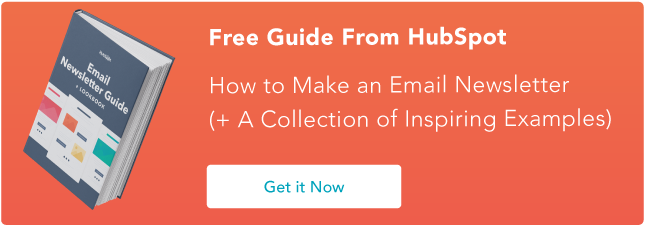
![]()
If Hubspot is of interest and you'd like more information, please do make contact or take a look in more detail here.
Credit: Original article published here.
